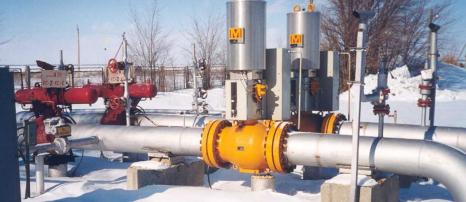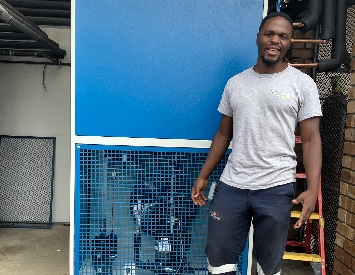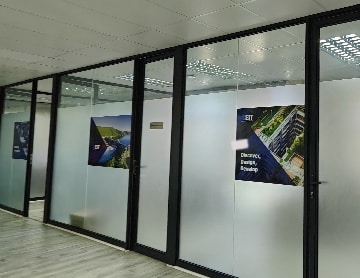Severe Service Valves
Go to Specific Subject : Severe Service Valve Description and Applications | Severe Service Control Valve Design for Abrasive Conditions | Severe Service Control Valve Design for Corrosive Conditions | Severe Service Control Valves on Cavitation Services | Severe Service Valves for Liquid Application | Severe Service Valves for Gas Application | Severe Service Valve Technical Papers and Articles | Severe Service Control Valves on Flashing / Outgassing Services |
Severe Service Valve Description and Applications
Severe Service Valves are required where the process can cause damage to conventional valves through erosion, high noise, cavitation, high vibration, possible mechanical damage to the valve trim, other components and the process equipment around the valve. These valves are generally specialist designs that overcome these issues by "smart" design. They are generally used for such applications as;
- Wellhead Choke
- Anti-surge Compressor Recycle
- Pipeline Surge Relief control
- Separator level control - surface choke valves
- Service Water Flow Control
- Fire Water Overboard Dump Valves on Offshore Facilities
- Fire Water Deluge System
- Fire Water Pump Discharge
- Aerodynamic Noise Control
- Cavitation/ Flashing Control
- Centrifugal Pump Minimum Flow Recirculation
- Steam Conditioning
- Turbine Bypass Valves
- Gas/Oil Separator Valves
- Gas to Flare
- Emergency Blowdown Valves Import and Export valves
Design of Severe Service Control Valves
Coping with cavitation, abrasion, flashing, high pressure drop or noise caused by these applications require valves with specific design features which take these factors into account. The design of a Severe Service Valve uses the following methods to provide valves capable of handling the severe service process conditions.
Severe Service Control Valve Design for Abrasive Condition
When a fluid contains abrasive particles such as sand etc., the selected valve should have a flowpath design which minimises turbulence and impingement.
The valve should be designed so that any of the parts subject to the process medium high velocity jet downstream of the valve orifice are specifically selected to cope with the process steam. High pressures and temperatures require specially selected valve bodies and trim.
Material selection of the valve and trim depends on the hardness of the particles, corrosion potential, angle of impingement, velocity and temperature. A typical resistant material used is Tungsten Carbide.
Severe Service Control Valve Design for Corrosive Conditions
Designing a Severe Service Valve to resist corrosion requires the following specification considerations;
- Select a valve and trim material that can withstand the corrosive fluid/material.
- It is good practice to select a valve design that is readily available in these materials, that is not a special which results in higher costs.
- Consider lined and diaphragm type valves, depending on the application plug or ball valves. Other than composite materials valves may be lined with tantalum or other metals, however plating is thin and subject to abrasion.
- Sometimes cheap quarter turn valves are used in the mining industry, however they require changing often and impose a high cost of ownership in maintenance and safety risk so the use of these valves these is not recommended.
Severe Service Control Valves on Cavitation Services
Cavitation may cause erosion, excessive noise and vibration. Any of these may cause catastrophic failure of the control valve. Hence severe service control valves are utilised. As no material can withstand the effects of imploding cavities, the severe service valve is engineered to avoid the formation of vapour cavities or prevent their implosion. The design of the valve trim thus sometimes includes;
- Streamlined flow path through the full-port expanded body avoiding turbulence and preventing erosion and vibration.
- Small flow channels and tortuous passages.
Severe Service Valves for Liquid Application
In liquid applications severe service valves are used where high pressure drops can cause cavitation which can quickly cause catastrophic damage to the valve trim and body. In addition erosive applications can also cause similar damage. High noise also occurs. This has severe safety ramifications if a standard control valve is utilised.
Typical Liquid process conditions for a severe service valve on liquid application are;
- Pressure drop of more than 5 Megapascals (Mpa) - 725 Pounds per square inch (psi)
- Flashing conditions Pv - P2 more than 3 Megapascals - 435 Pounds per square inch (psi)
- Multiphase conditions P1 - P2 more than 3 Megapascals - 435 Pounds per square inch (psi)
- Abrasive or Corrosive product
Severe Service Valves for Gas Application
In gas applications severe service valves are used where high pressure drops can cause cavitation which can quickly cause catastrophic damage to the valve trim and body. In addition erosive applications can also cause similar damage. High noise also occurs. This has severe safety ramifications if a standard control valve is utilised.
Severe Service Valve Papers and Applications
The following technical papers, articles and application examples are from Mokveld.
|
Axial Control Valve at Compressor Station in Morocco - 12" ASME 600 Valve |
Axial Surge Control Valves in Russia - Anti surge control at -60°C (-76°F) |
Axial Surge Relief Valve - The high-capacity proportional pilot design allows fast response and will eliminate the dangers of a pressure surge. All components operate solely on fluid static pressure to provide ultimate protection. Owing to stable opening behaviour, pilot design and consequently high effective capacity, the valve can fully protect the piping systems against dangerous and costly surge pressure damage.
Axial Excellence in China's Gas Transmission Network - By nature of design the axial control valve has unique benefits that make the valve specifically suitable for the more special and severe service control applications. In this article, Mokveld presents some benefits of the use of axial control valves and provides some specific project application examples.
Mokveld Subsea Control Valves Service Norwegian Oil Field - One of the technology gaps to be addressed was the development of large fast-acting subsea control valves. Several operators recognised the unique advantages of Mokveld's axial flow design in topside severe service control applications and approached Mokveld to investigate the axial flow concept as the basis for a subsea control valve.
Subsea Gas Compression with Mokveld Subsea Control Valves - Subsea gas compression is a technology approach that can boost recovery rates and lifetimes of offshore gas fields. Aker Solutions - at the forefront of subsea gas compression - was awarded the contract by operator Statoil to supply a complete subsea compression system for Norway’s Åsgard field. The project represents a quantum leap in subsea technology, and an important step in realising Statoil’s vision of a complete underwater plant.
Other Useful Links to Severe Service Valve Technical Papers and Articles
Control Valves for Critical Applications - Dr J Kisbauer, Samson A.G.- Know the causes of cavitation and how to prevent them.
Large Size Quarter Turn Control Valves can Improve Safety in Pipelines - Carlos Lorusso - Most control valve applications in pipelines are related to system start-up and shut down, emergency operations, delivery control, fluid speed control for pipeline internal examination. Selection of the right control valve is a key factor for long term successful performance for large applications where the safety and security of supply are important considerations. This document presents considerations for control valve selection to improve the safety and operation of oil and gas pipelines. Axial control valves are used when high pressure drop, high flow coefficients, low noise levels and bubble tight shut-off are required. Common applications include compressor start-up, shut-down and High Integrity Pressure Protection Systems (HIPPS). Triple offset valves (TOV) are used for large volume flow control, bubble tight shutoff, pressure drops of less than 30%.Typical applications include delivery point and controlled blow down. Ball valves are used for speed control for intelligent pig travel during pipeline examination and cleaning operations - from Tyco and pipeline conference.
Avoidin Pressure Surge Damage in Pipeline Systems? - Pressure surges occur in all fluid pipeline systems. There arise two types of damage from the surge phenomenon, fatigue and catastrophic failure. This paper addresses this phenomenon from the viewpoint of the available solutions rather than the mathematics and modelling involved in determining the quantum of the surge pressure.
Are You at Risk from Not Considering the Potential for Surges in a Piping System? - Geoffrey D Stone - This article raises a number of issues in respect of the risks you may be exposed to from the requirements to consider the pressure transients in a piping system design. The risks not only relate to physical damage but also the consequential risks that arise from such damage whether it is contractual, branding or loss of use. Piping systems are designed in Australia and overseas to a number of National Codes and Standards. In addition to this there are industry bodies that publish design guides and codes that are referred to in contract documents. These require that design for surge are taken into account to determine the loads and stresses in a piping system. This paper only addresses surge events from a liquid pressure transient. Events arising from condensate in steam or gas lines are not covered here. These events may be even more catastrophic as the velocities of the liquid column are much higher than in a liquid system. If nothing, read the section on Contract Requirements and consider the risks you run by being ignorant of this engineering topic - from Ventomat Australia Pty Ltd.
Diffusing Bubble Bombs - Proper Valve Sizing for Severe Service Can Help Lessen Wear and Damage from Cavitation - Gerald Liu, PE - Instrument technicians are often called by their instrument engineers to look at repeated control valve failure problems during plant shutdowns. From a maintenance point of view, the definition of "severe service" in control valves can be based on how long the valves last - From the excellent www.controlglobal.com.
Severe Service Control Valves on Flashing / Outgassing Services
Flashing occurs when the pressure drop across the valve causes a portion of the process stream to flash to a vapour. Outgassing is more complex, The paper Outgassing Versus Flashing - What are the Differences? from Emerson Process Management gives a A really good description.
|
Coming Soon! Professional Certificate of Competency in the Selection, Commissioning and Maintenance of Shutdown, Blowdown, Severe Service and Choke Valves Emergency Shutdown Systems (ESD) are a fundamental part of the safety systems associated with oil and gas, utility and other hazardous processes. Associated with these systems are specific valves which are used to isolate and blowdown the processes. These are referred to as Shutdown (SDV) and Blowdown (BDV) Valves respectively. Under emergency situations it is critical that these valves operate correctly. Thus the engineering of the valves and their associated actuators is paramount in ensuring plant safety. They must meet the Fire Safe and Reliability criteria determined by IEC16508 and IEC16511. This Professional Certificate of Competency (PCC) covers the requirements in detail. In addition, the course addresses Severe Service Valves and Wellhead Choke Valves. Severe Service Valves are required where the process can cause damage to conventional valves through erosion, high noise, cavitation, high vibration, possible mechanical damage to the valve trim, other components and the process equipment around the valve. These valves are generally specialist designs that overcome these issues by "smart" design. Get Further Information. |
Defining Severe Service Valves - No clear or universal industry definition or mechanism exists to describe and accurately define severe service valves (SSVs) from general purpose valves, yet such a definition would allow clients to benefit from improved process performance, increased profitability, safety and environmental protection. This high level paper looks to offer an objective definition - from CGIS.
The Following links are from CCI Valves.
Fluid Kinetic Energy as a Selection Criteria For Control Valves - Herbert L. Miller /Laurence R. Stratton - A selection criteria is provided that assures a control valve will perform its control function without the attendant problems of erosion, vibration, noise and short life. The criteria involves limits on the fluid kinetic energy exiting through the valve throttling area. Use of this criteria has resolved existing valve problems as demonstrated by retrofitting of the internals of many valves and vibration measurements before and after the retrofit. The selection criteria is to limit the valve throttling exit fluid kinetic energy to 70 psi (480 KPa) or less - from CCI Valves.
Getting Optimum Performance through Feedwater Control Valve Modifications - Brian Leimkuehler, P.E./ Sanjay V. Sherikar, P.E. - Good control of the feedwater system is very important for smooth operation at nuclear power plants. The performance of the feedwater control valves, which are the final control elements, is crucial in achieving the desired level of control in the system. Modifications were made to existing feedwater control valves at a 565 MWe BWR nuclear power plant. These modifications were part of an overall system upgrade, resulting in significantly improved controllability of the Feed Water Control system. The characteristics that are critical for best performance from the feedwater control valves are : fluid velocity control at all operating conditions, high rangeability, proper flow characterization, high actuator stiffness and good dynamic response. By analysis, and observed through experience, a properly designed and maintained pneumatic control system can provide the dynamic response and resolution necessary for feedwater control performance - from CCI Valves.
Evaluation of Control Valve Performance is Necessary in Plant Betterment Programs - Sanjay V. Sherikar, Ph.D., P.E. - Control valves affect the performance of power plant in terms of output, heat rate, reliability and availability because they are the final control elements in the operation. Therefore, critical evaluation of control valves must to be an integral part of any plant betterment program because the ultimate goal of such efforts is to improve the efficiency and reduce costs. Even control valves in the few severe service applications, which affect efficiency more than the rest of the valve population, have traditionally not been included in such efforts. Recent studies indicate that eliminating control valve problems alone can improve the heat rate of power plants in the range of 2% to 5%. The elements that are critical in realizing the potential benefits are: analyzing the whole system and quantifying the losses, identifying the root causes of the problems causing these losses and then, finally, eliminating the root causes of those problems. Methods to estimate loss due to control valve non-performance have to be judiciously applied, and sometimes developed, on a case-by-case basis, as shown by examples in this paper. The commonly observed causes of valve problems are discussed, followed by practical strategies for implementing solutions to the valve problems - from CCI Valves.
Technical Specification - Control Valve. based on “Control Valves - Practical Guides for Measurement and Control” Published by ISA - This specification prescribes the minimum mandatory requirements governing the design, sizing, and selection of control valves.
Linea Pistion Actuators - Samy, Stemler - High Reliability of actuation is of paramount importance in the nuclear power industry. Pneumatic actuators form the largest installed base with many in safety significant applications. This paper addresses the issues related to actuation, such as available Thrust, Stiffness, Sensitivity, Hysteresis, Dead band, Dynamic Stability and a sizing example. This paper also presents comparisons between various types of linear actuators and their relative advantages and disadvantages. Also presented will be evaluation techniques for troubleshooting actuator problems and improving plant performance.
Specifyin the Plant’s Control Valves - Miller - The subject of this paper is the proper specification of the control valve to avoid many of the problems noted above. To provide information so that the valves’ attributes that are important for the application are noted and that over specified needs are minimised. Over specifying needs result in compromise and trade off decisions in the design and result in higher initial costs.
Technology in Severe Service Control Valves - Sherikar - Severe service control valves are critical for safe, reliable and efficient operation of power plants. Such critical applications must be looked at differently from general service control valves because these applications have their own specific set of requirements for good long-term performance. The performance limits of control valves in such services is clearly a function of the technologies in them. Discussion on severe service valves is presented in order to aid the application of correct technology in such critical services.
Specifyin Control Valves for Severe-Service Applications - Larry Stratton and David Minoofar - This paper discusses the stringent requirements that valves must meet to safely operate and deliver long term performance under severe service conditions.
More technical papers on valve applications from CCI Sulzer can be found here.








